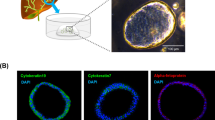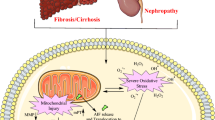Abstract
It has been known for a long time that portal fibrosis consecutive to experimental common bile duct ligation is reversible following obstacle removal, but the mechanisms involved remain unknown. We have studied the effect of bilioduodenal anastomosis and of simple biliary decompression on the remodeling of the lesion in bile duct-ligated rats. Rats were subjected to common bile duct ligation for 7 days or 14 days. Bilioduodenal anastomosis was performed after 14 days of bile duct ligation and animals sacrificed at intervals. In other animals, after 7 days or 14 days of ligation, the common bile duct was merely decompressed by bile aspiration and animals sacrificed 24 h later. Collagen deposition, α-smooth muscle actin expression and apoptosis were evaluated. Bile was collected and the bile acid profile assessed. After anastomosis, collagen deposition and α-smooth muscle actin expression decreased and were back to control values after 7 days. These parameters remained practically unchanged 24 h after biliary decompression. Bile duct ligation by itself induced apoptosis of some fibroblastic and bile ductular cells after 7 days; this was back to normal after 14 days. After anastomosis or decompression, apoptosis of both fibroblastic and bile ductular cells increased greatly and was accompanied by ultrastructural features of extracellular matrix degradation. Total bile acid content decreased after common bile duct ligation, the proportion of dihydroxylated bile acids decreasing and that of trihydroxylated bile acids increasing. Biliary decompression and anastomosis did not modify total concentration and composition of the biliary bile acid pool. In summary, we show that mere biliary decompression, by relieving the mechanical stress, is as effective as bilioduodenal anastomosis to induce apoptosis of portal cells that likely triggers portal fibrosis regression.



Similar content being viewed by others
References
Abdel-Aziz G, Lebeau G, Rescan PY, Clement B, Rissel M, Deugnier Y, Campion JP, Guillouzo A (1990) Reversibility of hepatic fibrosis in experimentally induced cholestasis in rat. Am J Pathol 137:1333–1342
Aronson DC, Chamuleau RA, Frederiks WM, Gooszen HG, Heijmans HS, James J (1993) Reversibility of cholestatic changes following experimental common bile duct obstruction: fact or fantasy? J Hepatol 18:85–95
Birns M, Masek B, Auerbach O (1962) The effects of experimental acute biliary obstruction and release on the rat liver. A histochemical study. Am J Pathol 40:95–112
Cameron GR, Prasad LBM (1960) Recovery from biliary obstruction after spontaneous restoration of the obstructed common bile-duct. J Pathol Bacteriol 80:127–136
Chiquet M (1999) Regulation of extracellular matrix gene expression by mechanical stress. Matrix Biol 18:417–426
Desmoulière A, Redard M, Darby I, Gabbiani G (1995) Apoptosis mediates the decrease in cellularity during the transition between granulation tissue and scar. Am J Pathol 146:56–66
Desmoulière A, Darby I, Costa AMA, Raccurt M, Tuchweber B, Sommer P, Gabbiani G (1997) Extracellular matrix deposition, lysyl oxidase expression, and myofibroblastic differentiation during the initial stages of cholestatic fibrosis in the rat. Lab Invest 76:765–778
Dionne S, Tuchweber B, Plaa GL, Yousef IM (1994) Phase I and Phase II metabolism of lithocholic acid in hepatic acinar zone 3 necrosis. Evaluation in rats by combined radiochromatography and gas liquid chromatrography-mass spectrometry. Biochem Pharmacol 48:1187–1197
Fluck J, Querfeld C, Cremer A, Niland S, Krieg T, Sollberg S (1998) Normal human primary fibroblasts undergo apoptosis in three-dimensional contractile collagen gels. J Invest Dermatol 110:153–157
Gall JA, Bhathal PS (1990) A quantitative analysis of the liver following ligation of the common bile duct. Liver 10:116–125
Grappone C, Pinzani M, Parola M, Pellegrini G, Caligiuri A, DeFranco R, Marra F, Herbst H, Alpini G, Milani S (1999) Expression of platelet-derived growth factor in newly formed cholangiocytes during experimental biliary fibrosis in rats. J Hepatol 31:100–109
Gravieli Y, Sherman Y, Ben-Sasson SA (1992) Identification of programmed cell death in situ via specific labeling of nuclear DNA fragmentation. J Cell Biol 119:493–501
Grinnell F, Zhu M, Carlson MA, Abrams JM (1999) Release of mechanical tension triggers apoptosis of human fibroblasts in a model of regressing granulation tissue. Exp Cell Res 248:608–619
Hammel P, Couvelard A, O'Toole D, Ratouis A, Sauvanet A, Flejou JF, Degott C, Belghiti J, Bernades P, Valla D, Ruszniewski P, Levy P (2001) Regression of liver fibrosis after biliary drainage in patients with chronic pancreatitis and stenosis of the common bile duct. N Engl J Med 344:418–423
Hsieh AH, Tsai CM, Ma QJ, Lin T, Banes AJ, Villarreal FJ, Akeson WH, Sung KL (2000) Time-dependent increases in type-III collagen gene expression in medical collateral ligament fibroblasts under cyclic strains. J Orthop Res 18:220–227
Iredale JP, Benyon RC, Pickering J, McCullen M, Northrop M, Pawley S, Hovell C, Arthur MJ (1998) Mechanisms of spontaneous resolution of rat liver fibrosis. Hepatic stellate cell apoptosis and reduced hepatic expression of metalloproteinase inhibitors. J Clin Invest 102:538–549
Kessler D, Dethlefsen S, Haase I, Plomann M, Hirche F, Krieg T, Eckes B (2001) Fibroblasts in mechanically stressed collagen lattices assume a "synthetic" phenotype. J Biol Chem 276:36575–36585
Krahenbuhl S, Talos C, Lauterburg BH, Reichen J (1995) Reduced antioxidative capacity in liver mitochondria from bile duct ligated rats. Hepatology 22:607–612
Lamireau T, Zoltowska M, Levy E, Yousef I, Rosenbaum J, Tuchweber B, Desmoulière A (2003) Effects of bile acids on biliary epithelial cells: proliferation, cytotoxicity, and cytokine secretion. Life Sci 72:1401–1411
Manabe N, Chevallier M, Chossegros P, Causse X, Guerret S, Trepo C, Grimaud JA (1993) Interferon-alpha 2b therapy reduces liver fibrosis in chronic non-A, non-B hepatitis: a quantitative histological evaluation. Hepatology 18:1344–1349
Meredith JE Jr, Fazeli B, Schwartz MA (1993) The extracellular matrix as a cell survival factor. Mol Biol Cell 4:953–961
Milkiewicz P, Roma MG, Elias E, Coleman R (2002) Hepatoprotection with tauroursodeoxycholate and beta muricholate against taurolithocholate induced cholestasis: involvement of signal transduction pathways. Gut 51:113–119
Miyoshi H, Rust C, Roberts PJ, Burgart LJ, Gores GJ (1999) Hepatocyte apoptosis after bile duct ligation in the mouse involves fas. Gastroenterology 117:669–677
Naito T, Kuroki S, Chijiiwa K, Tanaka M (1996) Bile acid synthesis and biliary hydrophobicity during obstructive jaundice in rats. J Surgical Res 65:70–76
Niland S, Cremer A, Fluck J, Eble JA, Krieg T, Sollberg S (2001) Contraction-dependent apoptosis of normal dermal fibroblasts. J Invest Dermatol 116:686–692
Perwaiz S, Tuchweber B, Mignault D, Gilat T, Yousef IM (2001) Determination of bile acids in biological fluids by liquid chromatrography-electrospray tandem mass spectrometry. J Lipid Res 12:114–119
Ramm GA, Carr SC, Bridle KR, Li L, Britton RS, Crawford DH, Vogler CA, Bacon BR, Tracy TF (2000) Morphology of liver repair following cholestatic liver injury: resolution of ductal hyperplasia, matrix deposition and regression of myofibroblasts. Liver 20:387–396
Rodrigues CM, Fan G, Ma X, Kren BT, Steer CJ (1998) A novel role for ursodeoxycholic acid in inhibiting apoptosis by modulating mitochondrial membrane perturbation. J Clin Invest 101:2790–2799
Rodrigues CM, Sola S, Castro RE, Laires PA, Brites D, Moura JJ (2002) Perturbation of membrane dynamics in nerve cells as an early event during bilirubin-induced apoptosis. J Lipid Res 43:885–894
Roelofsen J, Klein-Nulend J, Burger EH (1995) Mechanical stimulation by intermittent hydrostatic compression promotes bone-specific gene expression in vitro. J Biomech 28:1493–1503
Sano H, Ueda Y, Takakura N, Takemura G, Doi T, Kataoka H, Murayama T, Xu Y, Sudo T, Nishikawa S, Nishikawa SI, Fujiwara H, Kita T, Yokode M (2002) Blockade of platelet-derived growth factor receptor-β pathway induces apoptosis of vascular endothelial cells and disrupts glomerular capillary formation in neonatal mice. Am J Pathol 161:135–143
Silva RF, Rodrigues CM, Brites D (2001) Bilirubin-induced apoptosis in cultured rat neural cells is aggravated by chenodeoxycholic acid but prevented by ursodeoxycholic acid. J Hepatol 34:402–408
Skalli O, Ropraz P, Trzeciak A, Benzonana G, Gillessen D, Gabbiani G (1986). A monoclonal antibody against alpha-smooth muscle actin: a new probe for smooth muscle differentiation. J Cell Biol 103:2787–2796
Swartz MA, Tschumperlin DJ, Kamm RD, Drazen JM (2001) Mechanical stress is communicated between different cell types to elicit matrix remodeling. Proc Natl Acad Sci U S A 98:6180–6185
Tomaro ML, Batlle AM (2002) Bilirubin: its role in cytoprotection against oxidative stress. Int J Biochem Cell Biol 34:216–220
Tuchweber B, Desmoulière A, Bochaton-Piallat ML, Rubbia-Brandt L, Gabbiani G (1996) Proliferation and phenotypic modulation of portal fibroblasts in the early stages of cholestatic fibrosis in the rat. Lab Invest 74:1–14
Yousef IM, Bouchard G, Tuchweber B, Plaa G (1997) Monohydroxy bile acid induced cholestasis: role of biotransformation. Drug Metab Rev 29:167–181
Zimmermann H, Reichen J, Zimmermann A, Sagesser H, Thenisch B, Hoflin F (1992) Reversibility of secondary biliary fibrosis by biliodigestive anastomosis in the rat. Gastroenterology 103:579–589
Acknowledgements
This work was supported in part by the Région Aquitaine in France, by the Medical Research Council of Canada and by Fundação de Amparo à Pesquisa do Estado do Rio de Janeiro (Brazil). We thank the staff of the Biochemistry Department of Pellegrin Hospital (Bordeaux) for performing liver function tests.
Author information
Authors and Affiliations
Corresponding author
Rights and permissions
About this article
Cite this article
Costa, A.M.A., Tuchweber, B., Lamireau, T. et al. Role of apoptosis in the remodeling of cholestatic liver injury following release of the mechanical stress. Virchows Arch 442, 372–380 (2003). https://doi.org/10.1007/s00428-003-0773-7
Received:
Accepted:
Published:
Issue Date:
DOI: https://doi.org/10.1007/s00428-003-0773-7




